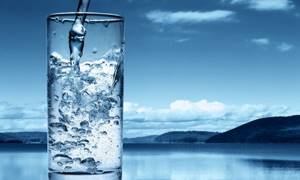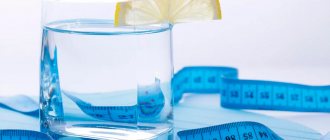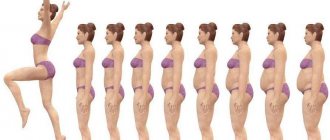Everyone makes the decision to fast for different reasons: to cleanse the body and restore a feeling of lightness, to get rid of ailments and become healthier, to lose extra pounds and regain their former shape. Regardless of the reasons that prompted a person to make a decision, it is necessary to prepare for the procedure theoretically and psychologically. The load on the body in the form of food refusal is tolerated differently by everyone, and in order for the result of hunger to be satisfactory, it is important to enter and exit it correctly. There are different durations of fasting and different types. Some people prefer to do a one-day fast once a week, others radically change their eating schedule for a longer period of time. There is an average course - fasting for 4 days. Let’s take a closer look at how to practice it, prepare and exit.
One-day fasting
Starvation
Starting to refuse food without preparation and training is strictly not recommended. Competent nutritionists suggest initially organizing fasting days, testing yourself for strength, eliminating unhealthy foods, and reducing the size of portions. To go through a four-day fast without problems or discomfort, try fasting for one day. The most important thing in hunger of any duration is the entrance and exit from it. It is these steps that are carried out incorrectly that cause failures, disorders and health problems.
First, minimize high-calorie foods and simple carbohydrates. A few days before the famine, try to bring your diet closer to the correct one. It is important to cleanse the intestines at the same time. To do this, you do not need to immediately take pharmaceutical drugs. There are so many natural remedies around us: dried fruits, vegetables with a laxative effect, fermented milk products. Choose a product that weakens and cleanses the intestines.
One-day fasting helps rid the body of impurities, helps control hunger, and forms correct gastronomic habits. To achieve success from fasting of any duration, it is important to have the right mindset, strong motivation and confidence in your abilities. To fast, you need to choose a free day to spend it for your own pleasure: in nature, doing what you love. It is necessary to prepare a sufficient supply of high-quality clean water. You can walk, read, engage in hobbies, and drink plenty of water.
Since the beginning of fasting can be considered the evening of the previous day, for dinner you can eat a vegetable salad without seasonings and drink tea with honey. If possible, move your meals to the morning.
On the next day after fasting, you should eat only light food in small quantities. Fried, smoked, and heavy foods are excluded. If you practice similar one-day fasting weekly, changes will not take long to arrive. Dietary discipline and food restrictions will help improve your condition and appearance. Only after adapting to one-day fasts can you switch to a longer fast of 4 days or more.
Read
About toxins in the human body
Four-day fasting: features
The hunger mindset alone is not enough. You need to undergo a full study to understand whether it is realistic to carry out the technique and whether the body will withstand it. If the doctor does not object to fasting, you can begin the procedure. Regarding theoretical preparation, everything is clear. It is important to know what the procedure is and how each stage goes. If the goal of giving up food is to get rid of the hated kilograms, you need to take a “before” photo. As a rule, this is a very powerful photograph that motivates you to finish what you started. Some girls said that having their own photo on the refrigerator door discouraged them from stopping or breaking their diet.
Having developed a nutrition plan, you need to remove harmful foods from your diet in advance. The preparatory period should consist mainly of the following dishes:
- cereal and cereal porridges;
- lean varieties of fish and meat;
- plant products;
- pure water and natural non-concentrated juices.

Water
Three to five days before the start of fasting, the diet consists entirely of plant products.
Rules for four-day dry fasting
Eliminating food and water from your diet is a very difficult challenge, and many are unable to do so. Four days of complete restriction can only be survived with well-planned actions. Frequent contact with temptations must be avoided. That is, it is important to spend as much time as possible in nature, doing your favorite activity, which is not too energy-consuming. It is not recommended to meet with friends, as even talking wastes energy and makes your throat dry out.
During this period, water is completely excluded; you cannot even contact it. After two or three days, the fasting person begins to feel unwell. This occurs due to intoxication; harmful accumulations begin to “move” throughout the body. The person feels dizzy, nauseated, and powerless. You can endure the condition while sleeping. It is recommended to go to bed and spend the acute period sleeping. The third or fourth day of fasting gives completely different sensations. Lightness appears and a surge of energy is noted.

Juices
It is very important to get out of dry hunger correctly. It is strictly forbidden to start eating and drinking heavily immediately after stopping the procedure. The extra lost kilograms will return, the digestive organs will not work properly.
The algorithm for breaking a four-day fast looks like this:
- for breakfast - water or non-concentrated juices from vegetables or fruits;
- for lunch – pureed vegetable soup;
- for an afternoon snack - several unsweetened fruits and fermented milk products;
- for dinner - vegetable salad or boiled vegetables.
In this way, they eat for as many days as they fasted. During the period of refusing food, the stomach has significantly decreased in volume, so you need to eat in small portions and avoid overeating. Often, fasting makes a person rethink his lifestyle and gastronomic habits. Many people then lead a healthy lifestyle and become vegetarians.
Read
Losing weight on dry fasting
How intermittent fasting helps you lose weight
A 2011 study compared the effectiveness of portion restriction with intermittent fasting.7 Subjects followed a Mediterranean diet, known for its health benefits.
The portion control group reduced their daily caloric intake by 25%. For example, if a person ate on average 2000 kcal per day, then after the start of the experiment he began to eat only 1500 kcal. That is, in a week a person received 10,500 kilocalories.
The intermittent fasting group received 100% of calories for five days, and then only 25% for two days. For example, the subjects received 2000 kcal per day, five days a week, and then for two days they managed with 500 kcal. The famous Michael Mosley 5:2 diet has the same structure. Over the course of a week, subjects from the intermittent fasting group received 11,000 kcal. A little more low-calorie group.
After six months, participants in both groups lost approximately the same amount of weight - 6.5 kg. But we already know that all diets only work for a short time. However, in the intermittent fasting group, insulin levels and levels of insulin resistance decreased significantly.
The intermittent fasting system is much more effective in helping to cope with the problem of obesity, because through long periods of low insulin (fasting) it helps get rid of insulin resistance.
Thanks to this method, the most dangerous visceral fat disappears first. In addition, low-density lipoprotein levels, lipoprotein levels and triglycerides improve.
Despite this, we still wonder more about what to eat rather than when.
Advertising
Rules for a four-day water fast
Water fasting involves avoiding food and drinking large amounts of liquid. With this option, it is also important to observe the correct entry and exit from hunger. They leave the process for as long as the fast lasted.

Fruits
With this type of fasting, you are allowed to drink water and take water procedures in any quantity. This helps improve the functioning of the sweat glands and remove waste products through the skin. After four days, the diet begins with non-concentrated fresh juice. For four days after the end of the fast, only vegetable broths, vegetable salads and unsweetened fruits are consumed. Do not eat meat and fish until the functioning of the digestive system is completely restored.
Important!
We do not recommend fasting without competent individual advice from an experienced specialist! Violation of schedules, sequence, and quantity of foods consumed (especially when coming out of fasting) can cause harm to your body.
It’s better not to fast at all than to do it incorrectly or thoughtlessly! Take care of your health!
Previous post Healthy nutrition options
Next Post Questions that will change your life
What happens to the body during fasting
Every hour, important changes occur in the body of a person who decides to fast. Every day brings you closer to the result and increases the chance of victory: over yourself, illness or excess weight.
The first day. On the first day, a cleansing enema is given to reduce the amount of toxins entering the bloodstream. Most often, a person feels irritated and balances between “I want to achieve results” and “why do I need this.” The feeling of hunger increases, and drinking a large amount of water does not always suppress hunger. The digestive system, without receiving a portion of food, begins to process accumulations, toxins enter the blood, and health becomes worse.
Second day. The second day goes easier. Hunger does not hurt as much or disappears altogether.
You practically don’t want to drink, but if it’s not dry hunger, you need to force yourself. The person has no strength and is bothered by an unpleasant taste in the mouth. Gradually during the day the condition improves and the realization comes that everything can be done. Hunger is practically not felt. It is important to shower frequently and drink plenty of water.
Day three. A person feels a surge of strength and increased mood. I don't feel hungry. You need to drink water with lemon to effectively remove deposits from the intestinal walls.
Day four. The person feels energetic and renewed. The result is noticeable to the naked eye: the waist size decreases. It is important to get out of hunger correctly.
Myth four: after breaking fast a person begins to overeat
Many people assume that fasting makes you hungry. Research results confirm that the next meal after a one-day fast, subjects eat more calories than usual. The amount of energy consumed from food increases from 2436 to 2914 kilocalories per day. But if we take the two-day period as a whole, the calorie deficit is still 1958 kcal. Increased caloric intake the day after fasting does not compensate for the caloric deficit caused by fasting.6 According to our clinic's experience, prolonged fasting reduces appetite.
Advertising
Results of a four-day fast
Doctors say that the result of the procedure will only be if you strictly follow all the recommendations. It is especially important to go out correctly and not return to those gastronomic habits that caused weight gain and toxin deposition.

Normalization of digestion
The result of the technique is not limited to lost weight:
- immunity is stimulated;
- pathogenic microflora in the body is destroyed;
- there is a clearing of waste and toxins;
- the functioning of the digestive system is normalized;
- improves appearance and skin condition;
- general health improves.
Refusal of food allows people to achieve their goals: get rid of constant colds, adjust body weight and volume, fight blues, apathy and loss of strength.
Read
About fiber against cholesterol and its effect on the body
Instant effect after fasting
A craving for simple and healthy food, the return of bright taste sensations, a renewal of feelings, and most importantly, the heart opens: a desire to explore the world appears, an inner joy awakens that people did not experience even in their youth. Healing from various diseases often occurs. A stable healing effect, up to the disappearance of “incurable” chronic diseases, is observed after six months to a year of regular fasting and proper nutrition.
A book is not enough to describe the processes occurring in the body during fasting. This article is for informational purposes only. Therefore, we will only emphasize once again: the purpose of fasting is to cleanse and heal the body. And in this capacity, healing fasting has no competitors. The experience of hundreds of famous researchers, scientists and book authors, including the personal experience of Goltis, testify: with the help of fasting, people were consciously cured of fatal diseases. They were cured after the doctors gave up and sent them home to die, promising several weeks or months of life.
Possible complications
Even if you fully believe in success and are determined to win, you need to know what unpleasant moments and complications can lie in wait for a starving person. If the symptoms are tolerable and not acute, it is necessary to continue fasting. If negative symptoms increase, it is necessary to start restorative nutrition and abandon the method for a while.

Headache
Often during the period of food refusal the following may be observed:
- Headache, dizziness and even fainting. One way to improve your well-being is to do a cleansing enema. If this doesn't help, you need to try switching. Very often, such symptoms are a completely natural reaction of the body to the release of waste and toxins from the depths of cells.
- A person gets cold or has a fever. Such a reaction can occur with improperly selected clothing or insufficient water intake during water fasting. Sometimes it is enough to reconsider these moments, and the condition returns to normal.
- Bad breath, coating on the tongue. This is a natural reaction of the body, and it is almost impossible to influence these processes. Enhanced hygiene is recommended. You can rinse your mouth with anti-inflammatory drugs recommended by traditional medicine.
- Cramps. This can happen when salts are actively removed from the body. To get rid of convulsive contractions, you need to drink salt water and relax.
- Pain in muscles and joints is eliminated with the help of water procedures, massage and self-massage.











